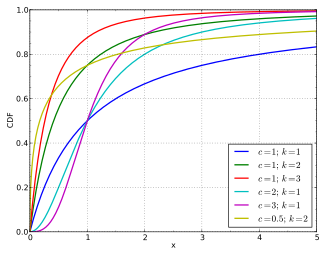Burr distribution
|
Probability density function  | |||
|
Cumulative distribution function  | |||
| Parameters |
| ||
|---|---|---|---|
| Support | |||
| CDF | |||
| Mean | where B() is the beta function | ||
| Median | |||
| Mode | |||
In probability theory, statistics and econometrics, the Burr Type XII distribution or simply the Burr distribution[1] is a continuous probability distribution for a non-negative random variable. It is also known as the Singh-Maddala distribution and is one of a number of different distributions sometimes called the "generalized log-logistic distribution". It is most commonly used to model household income (See: Household income in the U.S. and compare to magenta graph at right).
The Burr (Type XII) distribution has probability density function:[2][3]
and cumulative distribution function:
Note when c=1, the Burr distribution becomes the Pareto Type II distribution. When k=1, the Burr distribution is a special case of the Champernowne distribution, often referred to as the Fisk distribution.[4][5]
The Burr Type XII distribution is a member of a system of continuous distributions introduced by Burr (1942), which comprises 12 distributions.[6]
See also
- Dagum distribution, also known as the inverse Burr Distribution.
References
- ^ Burr, I.W. (1942) "Cumulative frequency functions," Annals of Mathematical Statistics, 13, 215–232
- ^ Maddala, G.S.. 1983, 1996. Limited-Dependent and Qualitative Variables in Econometrics. Cambridge University Press.
- ^ Tadikamalla, Pandu R. (1980), "A Look at the Burr and Related Distributions", International Statistical Review, 48 (3): 337–344, doi:10.2307/1402945, JSTOR 1402945
- ^ C. Kleiber and S. Kotz (2003). Statistical Size Distributions in Economics and Actuarial Sciences. New York: Wiley.
{{cite book}}: Invalid|ref=harv(help) See Sections 7.3 "Champernowne Distribution" and 6.4.1 "Fisk Distribution." - ^ Champernowne, D. G. (1952). "The graduation of income distributions". Econometrica. 20: 591–614.
{{cite journal}}: Invalid|ref=harv(help) - ^ See Kleiber and Kotz (2003), Table 2.4, p. 51, "The Burr Distributions."
Further reading
- Rodriguez, R.N. (1977) "A guide to Burr Type XII distributions", Biometrika, 64, 129–134










